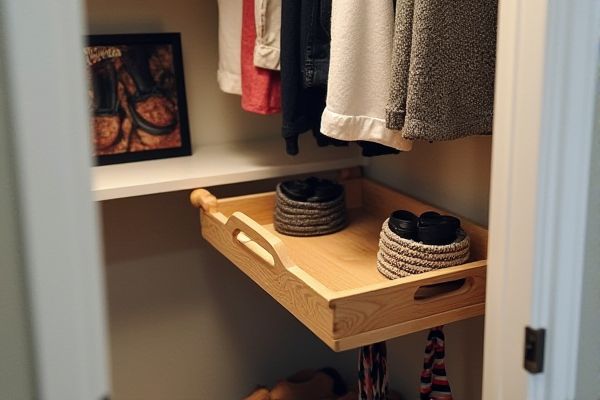
A closet valet stand offers a full-sized, vertical solution to organize clothing and accessories, providing hooks, hangers, and compartments for suits, ties, and shoes, while a valet tray is a compact, flat accessory designed to hold smaller items like watches, keys, and jewelry for quick, easy access. To discover which option best suits your lifestyle and space needs, continue reading the rest of the article.
Table of Comparison
| Feature | Closet Valet Stand | Valet Tray |
|---|---|---|
| Purpose | Organizes entire outfit, including clothes and accessories | Holds small items like keys, watches, and coins |
| Size | Large, floor-standing unit | Compact, tabletop or drawer accessory |
| Material | Wood, metal, or a combination | Leather, wood, metal, or plastic |
| Storage Capacity | Clothes, shoes, accessories | Small personal items |
| Portability | Less portable, fixed in place | Highly portable and versatile |
| Use Case | Bedroom or dressing area organization | Entryway, nightstand, or office desk |
| Price Range | Higher, $100-$300 | Lower, $10-$50 |
Introduction to Closet Valet Stand and Valet Tray
A closet valet stand offers a versatile solution for organizing your clothing and accessories, combining hanging space, shelves, and compartments in a single piece of furniture. A valet tray, typically smaller and portable, is designed to hold everyday essentials like wallets, keys, and watches, keeping them neatly arranged on dresser tops or nightstands. Choosing between a closet valet stand and a valet tray depends on your storage needs and available space, with the stand providing more extensive garment organization while the tray excels at managing small personal items.
What Is a Closet Valet Stand?
A closet valet stand is a standalone furniture piece designed to organize and neatly store clothing, accessories, and personal items in a bedroom or closet space. It typically includes features like a hanger for jackets or shirts, a trouser bar, and compartments or trays for small essentials, making daily outfit preparation more efficient. Compared to a valet tray, which is usually a compact, flat container primarily for holding smaller accessories, the valet stand offers more comprehensive storage and garment support.
What Is a Valet Tray?
A valet tray is a compact, often portable organizer designed to hold small personal items like keys, watches, coins, and jewelry, keeping them easily accessible and neatly contained. Unlike a closet valet stand, which typically includes a structure for hanging clothes, a valet tray focuses solely on organizing everyday accessories on a flat surface such as a dresser or nightstand. You can optimize your space by choosing a valet tray to streamline your daily routine and prevent clutter.
Key Features of Closet Valet Stands
Closet valet stands feature upright structures with hangers, shelves, and trays designed to organize suits, ties, and shoes efficiently. Their vertical design maximizes space in walk-in closets while keeping garments wrinkle-free and easily accessible. Built from durable materials like wood or metal, these stands often include compartments for watches, cufflinks, and wallets, enhancing daily outfit preparation.
Key Features of Valet Trays
Valet trays are compact organizers designed to keep everyday essentials such as watches, keys, wallets, and jewelry neatly arranged and easily accessible. They typically feature multiple compartments or sections made from materials like leather, wood, or metal to provide a stylish and functional storage solution for small personal items. Unlike closet valet stands, valet trays do not include hanging options for clothing, focusing solely on organizing accessories on flat surfaces like dressers or nightstands.
Benefits of Using a Closet Valet Stand
A closet valet stand provides a structured and upright solution for organizing your clothing, keeping suits, shirts, and accessories wrinkle-free and ready to wear. Unlike a valet tray, it maximizes vertical space, offering multiple compartments and hangers for efficient storage and easy access. This stand enhances your daily dressing routine by maintaining order and preserving your garments' quality.
Advantages of Choosing a Valet Tray
A valet tray offers a compact and organized solution for storing small personal items like watches, keys, and jewelry, making it ideal for your nightstand or dresser. It provides easy access to essentials without taking up much space, reducing clutter and enhancing convenience. Compared to a closet valet stand, a valet tray is more portable and versatile, fitting seamlessly into various rooms and lifestyles.
Space and Design Considerations
Closet valet stands offer a vertical design that maximizes floor space, making them ideal for compact rooms or walk-in closets where space efficiency is critical. Valet trays provide a low-profile, horizontal option perfect for placing on dressers or shelves, blending seamlessly with your existing decor without occupying extra floor area. Your choice depends on how much space you have and whether you prefer a stand-alone piece or a subtle accessory to organize your essentials.
Ideal Use Cases for Each Option
Closet valet stands are ideal for organizing entire outfits, including jackets, pants, and accessories, making them perfect for your bedroom or dressing area where you need a full wardrobe layout. Valet trays excel in storing smaller items like watches, cufflinks, and keys, offering a compact solution for entryways or nightstands. Choosing between the two depends on whether you need comprehensive outfit management or a dedicated spot for essential accessories.
Which Should You Choose: Closet Valet Stand vs Valet Tray?
Closet valet stands offer vertical storage with hangers and compartments, ideal for organizing suits, ties, and accessories neatly in a bedroom or dressing area. Valet trays provide a compact, flat surface designed for holding smaller items like watches, wallets, and keys, perfect for bedside tables or entryway consoles. Choose a closet valet stand for comprehensive garment organization or a valet tray for minimalist, accessible storage of daily essentials.
 homyna.com
homyna.com